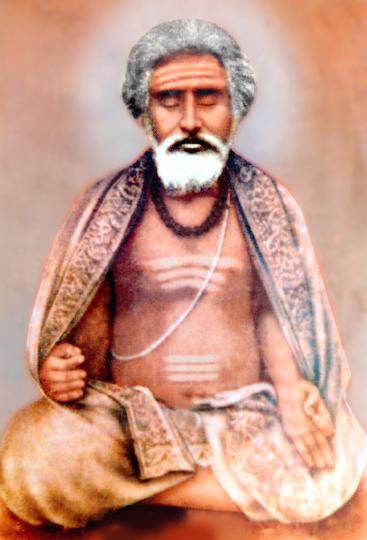Sri Vidya Peetham in Chennai, India
Bhaskara Prakasha Ashram's cornerstone is the Sri Vidya Peetham in Chennai, India. The Peetham has a rare temple of Goddess Maha Shodashi. The temple also houses the Samadhi of our Guru Sri Vimarshananda Nathendra Saraswathi Maha Swamigal.
Bhaskara Prakasha Ashram's members are Sri Vidya Upasakas who are well versed in the Vedas and the tantric practices of Sri Vidya Upasana. Sri Chakra Puja is performed at the lotus feet of Goddess Maha Shodashi every day at the Ashram. The Ashram also hosts and conducts hundreds of vedic activities every year including Sahasra Chandi Homam, Shata Chandi Homam, Sri Vidya Navavarna Homam, Rudra-Abhishekam, Devi Mahatmyam Parayanam, Veda Parayanam and Suvasini Pooja.
The Ashram in Chennai is led by our Guru Sri Vimarshananda Nathendra Maha Swamigal's poorvashrama sons Sri K.R. Yegnarathnam Deekshidar and Sri Ramakrishnan Deekshidar and Sri Gnanananda Teertha Swamigal.
Bhaskara Prakasha Ashram in Canada and USA is led by Sri Raghu Ranganathan and Smt. Akhila Ranganathan
The hallmark of our Ashram is the high quality of its Devi Upasakas, a reflection of the dedication of our Guru as a teacher.
Guru Parampara
श्री गुरुः सर्व कारण भूता शक्तिः || Sri Guruh Sarva Karana Bhootha Shakthih || The Guru is the divine Adi Parashakthi
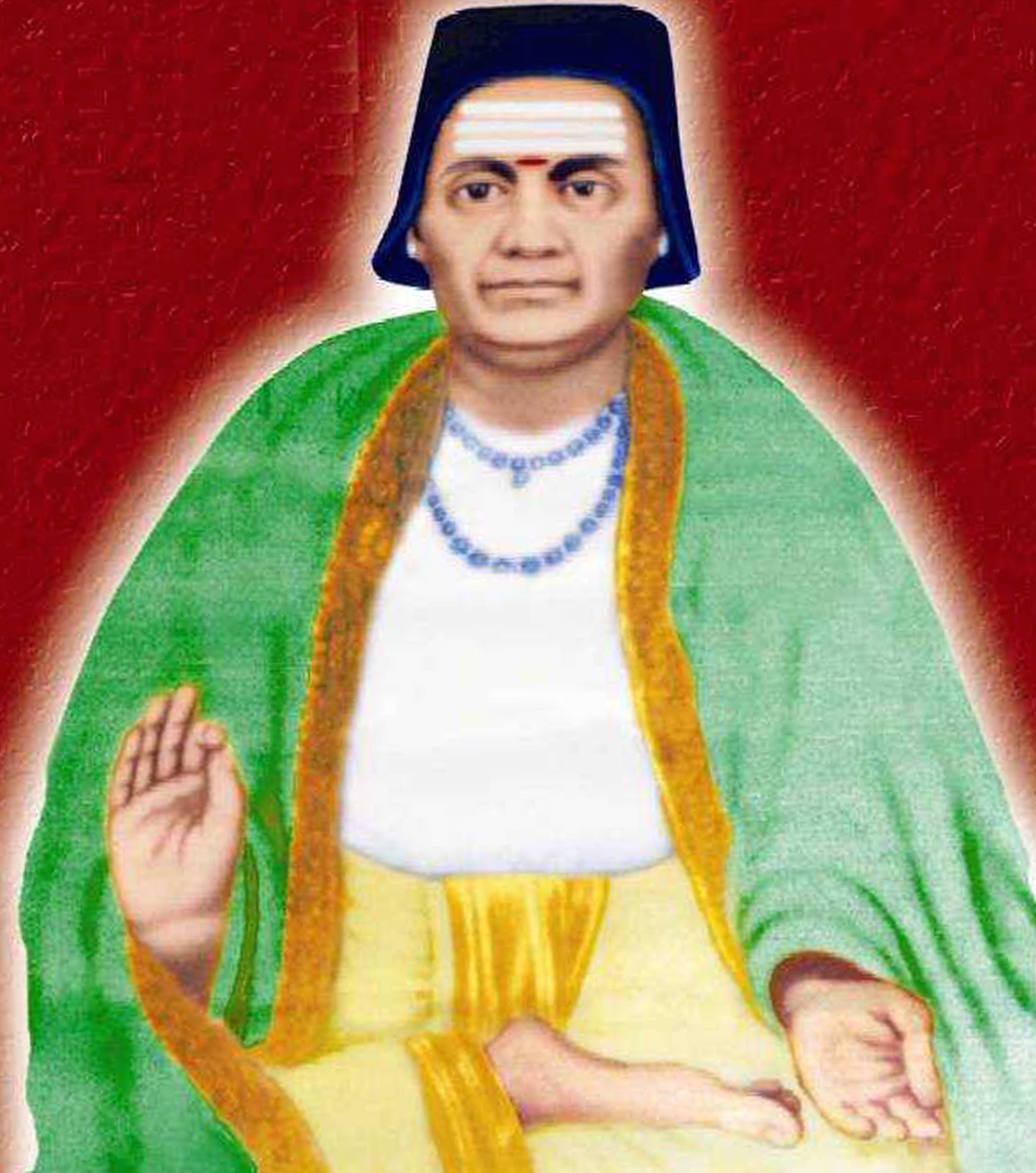
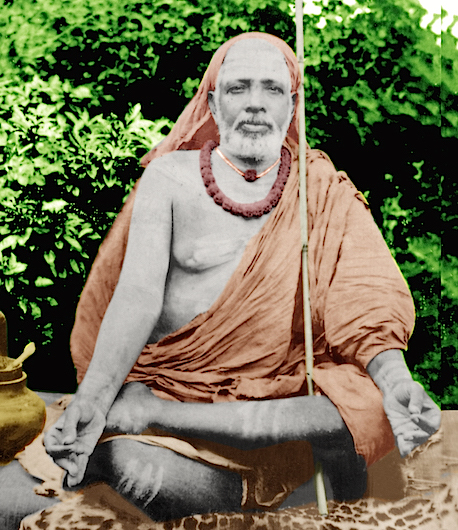
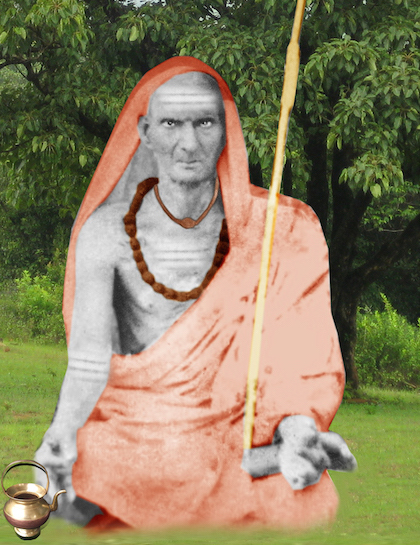
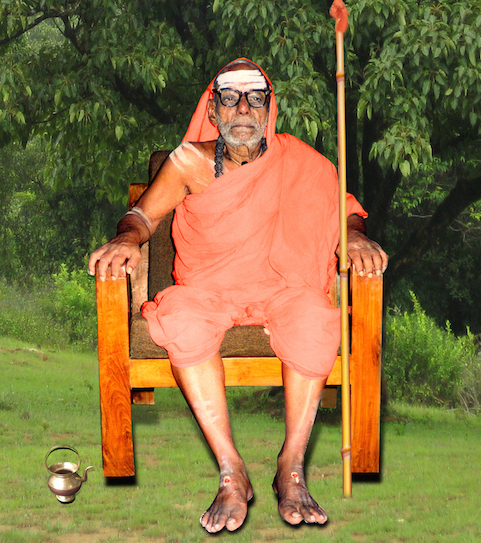
Sri Bhaskararaya (Bhaskararaya Makhin (1690 - 1785) was a great Devi Upasaka. One of the greatest masters and exponent of Sri Vidya, he is revered as an incarnation of Devi Herself. Three of his books are the holy triad of the worship of Devi: Varivasya Rahasya, along with his own commentary Prakasha, Nityashodashikarnava of Vamakeswara Tantra along with his commentary Setubandha and Lalitha Sahasranama along with his commentary Soubhagya Bhaskara. His commentary on Devi Mahatmyam called Guptavati is the most critical and authoritative commentary on the text till date. His disciple Maheshvarananda Natha who hailed from Tanjore, is the guru of Sri Kameshwarananda Natha, who is the Moola purusha of our guru parampara.
Sri Kameshwarananda Natha (1835 - 1891)
Guru Sri Kameshwarananda Natha is the Moola Purusha (Kutastha) of our Parampara. He was hailed as an Avatara Purusha and was considered an incarnation of Supreme Mother Goddess Sri Lalithambika . There is folklore describing divine signs like a shower of flowers, a drizzle of rain and lightning at the time of his birth signalling the arrival of a great divine soul. True to this prediction, he became a giant amongst his contemporaries, walking his path like a colossus. He was a Vedic scholar par excellence and performed every conceivable Vedic sacrifice prescribed in the Vedas.
He performed Soma Yaga every year, which in those times was normally done once or twice in a lifetime. He performed Vajapeya Yaga and many other major Yagas. To crown it all, he performed Poundarika Yaga, a very rare Vedic Sacrifice which only a selected few can perform. He also conducted Yagnas for Kings & Chieftains. He travelled the width and breadth of India and conducted a major Yaga for Maharaja of Dharbhanga.
He is revered as a Siddha Purusha - an accomplished soul having very rare and various occult powers at his command. He used to spend six months every year in forests in isolation to do intense penance and meditation to achieve the wisdom of Sages. He would then come back home for the next six months to fulfil his obligations as a Grihastha (householder). He was a Tantric Yogi of a very rare kind. It is said that several times in the midst performing a Pooja, he would go into the Yogic Meditative mode and become fully immersed in Samadhi Yoga for days together. During this period, he would appear completely dead to outside world and fully awakened to inner consciousness. When he came out of the Samadhi state to regular consciousness, he would pick up at the exact place in the Pooja where he had left off. He founded Sri Lalithambika Mutt and temple of Goddess Sri Raja Rajeshwari in Suthamalli Village, situated on the banks of River Tamrabharani in Tamil Nadu, India. The temple has an idol of Lalithambika with a huge Sricharam in front of her. When Narasimha Bharathi of Sringeri Mutt visited the temple in 1906 said it is verily the Kanchi in the North and called it "Dakshina Kanchi". There are 2 Shiva lingas installed by him on the either side of Lalithambika. It is said that right after he did one Soma yaaga, he used to do a pratishta of one Shiva linga next to Lalitambika. We can see 4 Shiva lingas here. It is said he did a 5th one too but did the installation of lingam in another temple in the neighbourhood. This is why he was called Bahu Somayaji. Our parampara is called Suttamalli parampara and Sri Kameswarananda was also called Kovil appa. He also established a Veda Pathasala in the Mutt to impart oral learning of Vedas. He moved to Varanasi later in his life and attained Mahasamadhi there. His prime disciple was Sri Ramananda Natha.
Sri Ramananda Natha (1856 - 1920)
Sri Ramananda Natha, was the Principal of a reputed Sanskrit college in Kallidaikuruchi, Tamil Nadu. Apart from performing all Vedik rituals and Yagnas as ordained in our Shastras, Sri Ramananda Natha was an intellectual giant, a scholar par excellence, a man of very high calibre in Sanskrit who mastered all four branches of Shastras - Mimamsa, Vyakarana ,Nyaya & Vedanta. He was a realised soul, a Jeevan Mukta (liberated soul while living), a Tantric and Vedantic Guru of the highest order. Both a Seer and Sri Vidya upasaka, he was a living example of a rare fusion of theoretical truths of Vedanta made practicable by Sri Vidya Upasana. During Ramananda Natha’s period in South India till he departed to Varanasi, he was served and taken care of both physically and religiously with utmost devotion and dedication by his prime disciple, Sri Prakashananda Natha and his wife Sri Vimarshamba. In his later years, Sri Ramananda Natha finally settled down in Varanasi. Kashi Maharaja & other learned pundits patronised him as a mark of respect for his rare genius, wisdom and his intellectual knowledge in Vedanta. He authored an independent Vedantic work namely “Shroutakhandartha Siddhi” published by Kashi Maharaja. He installed an idol of Supreme Mother Goddess Sri Rajarajeshwari in Hanuman Ghat, Varanasi at the banks of Divine River Ganga. He attained Mahasamadhi looking at Mother Ganga in a meditative and tranquil posture.
Sri Prakashananda Natha (1877 - 1962)
Sri Prakashananda Natha was a well-known authority on Sri Vidya, a highly reputed Sanskrit and Vedic scholar and also a sincere and rigorous practitioner of all Vedic rites as ordained in Dharma Shastras. He was a Nityagnihotri, obtained Sanyasa in his later years and attained Mahasamadhi in Varanasi, India. He also wrote “Yati Dharma Pradeepika,” an authentic book on all the duties of a Yati (Sanyasi) and Vedic rituals associated from the beginning to the end of a Sanyasin’s life. The foreword of this book was written by none other than, Jagadguru Shri Chandrasekharendra Saraswati Swamigal. He passed on total and complete knowledge of Sri Vidya and Vedic Dharma Shastra to his Sishya Sri Vimarshananda Natha - Our Guru.
Sri Vimarshananda Natha (1902 - 1996)
Sri Vimarshananda Nathendra Saraswati Mahaswamigal, who was known as S. Rengasamy Dikshithar before he took Sanyasa, was born in May 1902 in Krishnapuram, a village in Tamil Nadu, India. He started studying the Vedas from the age of 8 in a traditional Pathashala under the direct guidance of Sri Ramanatha Ghanapadigal, a knowledgeable and reputed Vedic scholar of that period. After completion of his Vedic studies in the Pathashala, he was trained in all the Vedic rituals, including grand Yagnas like the Soma Yaga, which is ordained in the Karma Kanda of the Vedas.
At the age of 30, he was initiated into Sri Vidya Upasana Marga by his father Shri Prakashanandanatha, who thus became his Diksha Guru.
Sri Vidya Upasana
Belonging to the reputed and illustrious Suthamalli Parampara of towering masters, it is no wonder that our Guru Sri Vimarshananda Natha is a great master of masters in Sri Vidya Upasana. He also excelled in the Vedic discipline - a benchmark that separates other Sri Vidya traditions from ours. Tantric texts and doctrines are essentially based on Vedas and as such they derive their authority from Vedas. Unless you are conversant with Vedic lore, you cannot fully appreciate the Tantric practices or the values and truths stated therein. Having been proficient in both Vedic & Tantric Systems, our Guru was able to teach correct practices for various religious rites and functions covering a wide spectrum of activities like Pooja, Yagna, Japa and Parayana of various Deities.
He initiated numerous people on Sri Vidya Mantra and it is to his credit that he adopted a flexible and practical attitude to prescribe procedures to practice Sri Vidya Upasana depending upon the temperament , competency, capability, attitude and aptitude of the followers. In fact, rigidity and inflexibility in earlier times made it almost impossible to have access to Sri Vidya Upasana.
He was a perfectionist who always insisted on 100% dedication and commitment. He insisted on correct intonation and pronunciation while reciting Vedas or chanting religious texts. He taught orally the essential Vedic texts, Upanishads, Sri Lalitha Sahasranama, Lalitha Trisati and other related Devi Stotras, Chandi Saptashati Parayana and other essential mantras to his disciples in a most authentic manner.
He performed Sri Vidya Upasana in all its gross, subtle and transcendental forms for a continuous uninterrupted period of 65 years from the age of 30. He performed Chakra Sadhana as prescribed in Nityashodashikarnava Tantra. The Chakra Sadhana involves nine months of uninterrupted Sri Chakra Pooja and Sri Vidya Mantra Japa in its most detailed format. He strictly followed rigorous injunctions and prohibitions per instructions from his Guru. This is a rare feat for any Sri Vidya Upasaka of repute. This made him a Siddha Purusha and conferred him all psychic, occult and supernatural powers.
Establishing Bhaskara Prakasha Ashram
He established Bhaskara Prakasha Ashram as a mark of respect, recognition, remembrance and reverence to the Great Tantrikacharya Sri Bhaskararaya who is considered the incarnation of Supreme Mother Goddess Herself, and his Guru Sri Prakashananda Natha.
He performed and conducted countless Sri Vidya Homams and Chandi Yagnas in many parts of India and initiated numerous people into the path of Sri Vidya Upasana Marga. He conducted the Sahasra Chandi Maha Yagna four times in his Ashram. He performed “Trishati Brahmana Bhojanam,” which involved honouring, propitiating, feeding and worshiping 300 Brahmins by invoking in them the 300 names of Supreme Mother Goddess mentioned in “Lalitha Trishati Stotra” just prior to his taking Sanyasa in February 1982.
The prana pratishtha for the first ever Vigraha made for Goddess Maha Shodashi was performed by Sri Maha Swamigal in 1994 in Bhaskara Prakasha Ashram, Chennai. Our Guru attained Mukthi on Mahalaya Amavasya day in 1996 and his Samadhi is consecrated below Goddess Maha Shodashi at Bhaskara Prakasha Ashram.
श्री विमर्शानन्दनाथम् सत्याम्बा सहितम् गुरुं | हृद् पद्म कर्णिकामध्ये भावयेत् सर्व सिद्धये ||
श्री प्रकाशानन्दनाथं विमर्शाम्बायुतम् गुरुं | हृद् पद्म कर्णिकामध्ये भावयेत् सर्व सिद्धये ||
श्री रामानन्दनाथं रामाम्बासहितम् गुरुं | हृद् पद्म कर्णिकामध्ये भावयेत् सर्व सिद्धये ||
